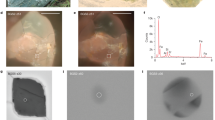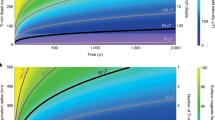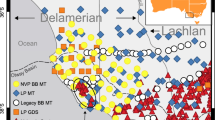Abstract
Palaeomagnetic studies of Apollo samples indicate that the Moon generated a magnetic field for at least 2 billion years1,2. However, the geometry of the lunar magnetic field is still largely unknown because the original orientations of essentially all Apollo samples have not been well constrained. Determining the direction of the lunar magnetic field over time could elucidate the mechanism by which the lunar dynamo was powered and whether the Moon experienced true polar wander. Here we present measurements of the lunar magnetic field 3.7 billion years ago as recorded by Apollo 17 mare basalts 75035 and 75055. We find that 75035 and 75055 record a mean palaeointensity of ~50 μT. Furthermore, we could infer from the magnetization direction of 75055 and the layering of its parent boulder that the inclination of the magnetic field at the time was 34 ± 10°. Our recovered inclination is consistent with, but does not require, a selenocentric axial dipole (SAD) field geometry: a dipole in the centre of the Moon and aligned along the spin axis. Additionally, although true polar wander is not required by our data, true polar wander paths inferred from some independent studies of lunar hydrogen deposits and crustal magnetic anomalies4,5,6 are consistent with our measured paleoinclination.
This is a preview of subscription content, access via your institution
Access options
Access Nature and 54 other Nature Portfolio journals
Get Nature+, our best-value online-access subscription
$29.99 / 30 days
cancel any time
Subscribe to this journal
Receive 12 digital issues and online access to articles
$119.00 per year
only $9.92 per issue
Buy this article
- Purchase on Springer Link
- Instant access to full article PDF
Prices may be subject to local taxes which are calculated during checkout



Similar content being viewed by others
Data availability
The palaeomagnetic data that support the findings of this study are available from the Magnetic Information Consortium (MagIC) database at http://www2.earthref.org/MagIC/17123. All other data requests and correspondence should be directed to C.I.O.N. Source data are provided with this paper.
References
Weiss, B. P. & Tikoo, S. M. The lunar dynamo. Science 346, 1246753 (2014).
Tikoo, S. M. et al. A two-billion-year history for the lunar dynamo. Sci. Adv. 3, e1700207 (2017).
Potter, D. K. Novel magnetic techniques for rapidly detecting palaeomagnetically important single-domain iron particles and obtaining directional palaeomagnetic data from ‘unoriented’ lunar rock samples. Can. Aeronaut. Space J. 57, 12–23 (2011).
Cournède, C., Gattacceca, J. & Rochette, P. Magnetic study of large Apollo samples: possible evidence for an ancient centered dipolar field on the Moon. Earth Planet. Sci. Lett. 331-332, 31–42 (2012).
Hood, L. L. Central magnetic anomalies of Nectarian-aged lunar impact basins: probable evidence for an early core dynamo. Icarus 211, 1109–1128 (2011).
Oliveira, J. S. & Wieczorek, M. A. Testing the axial dipole hypothesis for the Moon by modeling the direction of crustal magnetization. J. Geophys. Res. Planets 122, 383–399 (2017).
Evans, A. J., Tikoo, S. M. & Andrews-Hanna, J. C. The case against an early lunar dynamo powered by core convection. Geophys. Res. Lett. 45, 98–107 (2018).
Dwyer, C. A., Stevenson, D. J. & Nimmo, F. A long-lived lunar dynamo driven by continuous mechanical stirring. Nature 479, 212–214 (2011).
Cébron, D., Laguerre, R., Noir, J. & Schaeffer, N. Precessing spherical shells: flows, dissipation, dynamo and the lunar core. Geophys. J. Int. 219, S34–S57 (2019).
Stys, C. & Dumberry, M. A past lunar dynamo thermally driven by the precession of its inner core. J. Geophys. Res. Planets 125, e2020JE006396 (2020).
Le Bars, M., Wieczorek, M. A., Karatekin, Ö., Cébron, D. & Laneuville, M. An impact-driven dynamo for the early Moon. Nature 479, 215–218 (2011).
Suavet, C. et al. Persistence and origin of the lunar core dynamo. Proc. Natl Acad. Sci. USA 110, 8453–8458 (2013).
Scheinberg, A. L., Soderlund, K. M. & Elkins-Tanton, L. T. A basal magma ocean dynamo to explain the early lunar magnetic field. Earth Planet. Sci. Lett. 492, 144–151 (2018).
Olson, P. & Christensen, U. R. Dipole moment scaling for convection-driven planetary dynamos. Earth Planet. Sci. Lett. 250, 561–571 (2006).
Snape, J. F. et al. The timing of basaltic volcanism at the Apollo landing sites. Geochim. Cosmochim. Acta 266, 29–53 (2019).
Schmitt, H. H. et al. Revisiting the field geology of Taurus–Littrow. Icarus 298, 2–33 (2017).
Garrick-Bethell, I., Perera, V., Nimmo, F. & Zuber, M. T. The tidal–rotational shape of the Moon and evidence for polar wander. Nature 512, 181–184 (2014).
Shea, E. K. et al. A long-lived lunar core dynamo. Science 335, 453–456 (2012).
Schubert, G. & Soderlund, K. M. Planetary magnetic fields: observations and models. Phys. Earth Planet. Inter. 187, 92–108 (2011).
Weber, R. C., Lin, P.-Y., Garnero, E. J., Williams, Q. C. & Lognonné, P. Seismic detection of the lunar core. Science 331, 309–312 (2011).
Christensen, U. R. A deep dynamo generating Mercury’s magnetic field. Nature 444, 1056–1058 (2006).
Takahashi, F., Shimizu, H. & Tsunakawa, H. Mercury’s anomalous magnetic field caused by a symmetry-breaking self-regulating dynamo. Nat. Commun. 10, 208 (2019).
Maxwell, R. E. & Garrick-Bethell, I. Evidence for an ancient near-equatorial lunar dipole from higher precision inversions of crustal magnetization. J. Geophys. Res. Planets 125, e06567 (2020).
Siegler, M. A. et al. Lunar true polar wander inferred from polar hydrogen. Nature 531, 480–484 (2016).
Wolfe, E. W. et al. The Geologic Investigation of the Taurus-Littrow Valley; Apollo 17 Landing Site, with a Section on Apollo 17 Lunar Surface Photography Professional Paper 1080 (Astrogeology Science Center, U.S. Government Publishing Office, 1981).
Meyer, C. Lunar Sample Compendium (Astromaterials Research & Exploration Science, 2010); http://curator.jsc.nasa.gov/lunar/lsc/
Cashman, K. V., Thornber, C. R. & Kauahikaua, J. P. Cooling and crystallization of lava in open channels, and the transition of pāhoehoe lava to ‘a’ā. Bull. Volcanol. 61, 306–323 (1999).
Self, S., Keszthelyi, L. & Thordarson, T. The importance of pāhoehoe. Annu. Rev. Earth Planet. Sci. 26, 81–110 (1998).
Donohue, P. H. & Neal, C. R. Quantitative textural analysis of ilmenite in Apollo 17 high-titanium mare basalts. Geochim. Cosmochim. Acta 149, 115–130 (2015).
Brown, G. M., Peckett, A., Emeleus, C. H., Phillips, R. & Pinsent, R. H. Petrology and mineralogy of Apollo 17 mare basalts. In Proc. 6th Lunar Science Conference (ed. Merrill, R. B.) 1–13 (Pergamon Press, 1975).
Murase, T. & McBirney, A. R. Viscosity of lunar lavas. Science 167, 1491–1493 (1970).
Head, J. W.III Lunar volcanism in space and time. Rev. Geophys. 14, 265–300 (1976).
Manga, M. Waves of bubbles in basaltic magmas and lavas. J. Geophys. Res. Solid Earth 101, 17457–17465 (1996).
Wang, H. et al. Lifetime of the solar nebula constrained by meteorite paleomagnetism. Science 627, 623–627 (2017).
Tikoo, S. M. et al. Magnetic fidelity of lunar samples and implications for an ancient core dynamo. Earth Planet. Sci. Lett. 337-338, 93–103 (2012).
Suavet, C., Weiss, B. P. & Grove, T. L. Controlled-atmosphere thermal demagnetization and paleointensity analyses of extraterrestrial rocks. Geochem. Geophys. Geosyst. 15, 2733–2743 (2014).
Garrick-Bethell, I., Weiss, B. P., Shuster, D. L. & Buz, J. Early lunar magnetism. Science 323, 356–359 (2009).
Kirschvink, J. L. The least-squares line and plane and the analysis of palaeomagnetic data. Geophys. J. Int. 62, 699–718 (1980).
Tauxe, L. & Staudigel, H. Strength of the geomagnetic field in the Cretaceous Normal Superchron: new data from submarine basaltic glass of the Troodos Ophiolite. Geochem. Geophys. Geosyst. 5, 2003GC000635 (2004).
Tauxe, L. et al. PmagPy: software package for paleomagnetic data analysis and a bridge to the Magnetics Information Consortium (MagIC) Database. Geochem. Geophys. Geosyst. 17, 2450–2463 (2016).
Allmendinger, R. W., Cardozo, N. C. & Fisher, D. Structural Geology Algorithms: Vectors and Tensors 44–98 (Cambridge Univ. Press, 2013).
Cardozo, N. C. & Allmendinger, R. W. Spherical projections with OSXStereonet. Comput. Geosci. 51, 193–205 (2013).
Tikoo, S. M. et al. Decline of the lunar core dynamo. Earth Planet. Sci. Lett. 404, 89–97 (2014).
Paterson, G. A., Heslop, D. & Pan, Y. The pseudo-Thellier palaeointensity method: new calibration and uncertainty estimates. Geophys. J. Int. 207, 1596–1608 (2016).
Stephenson, A. & Collinson, D. W. Lunar magnetic field palaeointensities determined by an anhysteretic remanent magnetization method. Earth Planet. Sci. Lett. 23, 220–228 (1974).
Tauxe, L. Essentials of Paleomagnetism (Univ. of California Press, 2010).
Halgedahl, S. L., Day, R. & Fuller, M. The effect of cooling rate on the intensity of weak-field TRM in single-domain magnetite. J. Geophys. Res. Solid Earth 85, 3690–3698 (1980).
Bryson, J. F. J., Weiss, B. P., Harrison, R. J., Herrero-Albillos, J. & Kronast, F. Paleomagnetic evidence for dynamo activity driven by inward crystallisation of a metallic asteroid. Earth Planet. Sci. Lett. 472, 152–163 (2017).
Press, W., Teukolsky, S., Vertterling, W. & Flannery, B. in Numerical Recipes in C: The Art of Scientific Computing 2nd edn, 650–655 (Cambridge Univ. Press, 1992).
Jelinek, V. Characterization of the magnetic fabric of rocks. Tectonophysics 79, T63–T67 (1981).
Girdler, R. W. The measurement and computation of anisotropy of magnetic susceptibility of rocks. Geophys. J. Int. 5, 34–44 (1961).
Hood, L. L. & Artemieva, N. A. Antipodal effects of lunar basin-forming impacts: initial 3D simulations and comparisons with observations. Icarus 193, 485–502 (2008).
Daily, W. D. & Dyal, P. Theories for the origin of lunar magnetism. Phys. Earth Planet. Inter. 20, 255–270 (1979).
Dyal, P., Parkin, C. W. & Daily, W. D. Global lunar crust: electrical conductivity and thermoelectric origin of remanent magnetism. In Proc. 8th Lunar Science Conference (ed. Merrill, R. B.) 767–783 (Pergamon Press, 1977).
Takahashi, F., Tsunakawa, H., Shimizu, H., Shibuya, H. & Matsushima, M. Reorientation of the early lunar pole. Nat. Geosci. 7, 409–412 (2014).
Runcorn, S. K. Lunar magnetism, polar displacements and primeval satellites in the Earth–Moon system. Nature 304, 589–596 (1983).
Acknowledgements
We acknowledge funding from the NASA Solar System Workings Program (grant no. NNX15AL62G) to B.P.W. and from the NASA Solar System Exploration Virtual Institute (grant no. NNA14AB01A) to B.P.W. Additional funding support is acknowledged from the Simons Foundation (grant no. 556352) to C.I.O.N. We thank CAPTEM for the loan of samples. We thank R. Wells for assistance with sample orientation and photogrammetry. We thank L. de Groot, B. de Groot and the Utrecht University glass workshop for assistance with building a customized sample-handling system for anisotropy measurements. We thank S. Stanley for helpful discussions on dynamo theory. We thank F. Vervelidou for independently verifying the paleomagnetic data analysis.
Author information
Authors and Affiliations
Contributions
C.I.O.N. and B.P.W. wrote the paper. B.P.W. and H.H.S. conceived the study. C.I.O.N., B.L.G., A.B. and J.S. collected the palaeomagnetic data. C.I.O.N., B.P.W. and B.L.G. analysed the data and reconstructed palaeogeographic sample orientations. A.S.P.R. conducted the impact simulations.
Corresponding author
Ethics declarations
Competing interests
The authors declare no competing interests.
Additional information
Peer review information Nature Astronomy thanks Beck Strauss, Romain Tartese and the other, anonymous, reviewer(s) for their contribution to the peer review of this work.
Publisher’s note Springer Nature remains neutral with regard to jurisdictional claims in published maps and institutional affiliations.
Extended data
Extended Data Fig. 1 Demagnetization of NRM in 75035 and 75055.
Orthographic projections in laboratory coordinates (Table 1) show the nautral remanent magnetization (NRM) vector during alternating field demagnetization projected along the North-East (closed squares) and Up-East (open symbols) directions. Stable components are shown by blue (low coercivity, LC), purple (medium coercivity, MC) and red (high coercivity, HC) arrows, respectively. Data shown here are not corrected for remanence anisotropy. The peak AF is shown by the colour bar. a, Specimen 75035,242Ae. b, Specimen 75035,242Bg. c, Specimen 75055,127Aa. d, Specimen 75055,127Ae.
Extended Data Fig. 2 Geographic context of Station 5 where samples 75035 and 75055 were collected.
Figure adapted from ref. 25. (a) Panorama 19 from ref. 25 using astronaut photographs AS17-145-22181, 22183, 22159 and 22160. The panorama shows a north-east view of the Taurus-Littrow valley. (b) Sketch corresponding to the panoramic photograph in (a). The locations of 75035 and 75055 are shown. (c) Map showing the location from which the panorama was taken and the position of 75035 and 75055 relative to Camelot crater.
Extended Data Fig. 3 An example of the planar features in large blocks around Camelot Crater that were used to infer paleohorizontal.
Panorama using astronaut photographs AS17-133-20330 to AS17-133-20335. Astronaut E.A. Cernan is standing next to the block from which 75055 was sampled.
Extended Data Fig. 4 Estimation of the orientation of planar lava flow features on the 75055 parent boulder.
Measurements are summarized in Table S2. (a) Astronaut photograph AS17-145-22183. (b) - (l) Astronaut photographs AS17-145-22141 to AS17-145-22151 taken from a variety of orientations around the block. The trends and plunges of the planar features were measured as shown by the marked reference features. The colour of the trend arrow corresponds to the face on which the linear features were measured. (m) Equal area stereographic projection showing the orientation of the planar features with a strike and dip of 243∘/36∘. The plane of best fit was calculated from the measured trends and plunges of linear features identified on three faces of the boulder, coloured green, yellow and pink. (n) Annotated copies of (a) and (g) show the three faces identified on the boulder identified by the green, yellow and pink colours.
Supplementary information
Supplementary Information
Supplementary Text 1–5, Figs. 1–19, Equations 1–3 and Tables 1–11.
Source data
Source Data Fig. 2
Raw data for plots.
Source Data Extended Data Fig. 1
Raw data for plots.
Rights and permissions
About this article
Cite this article
Nichols, C.I.O., Weiss, B.P., Getzin, B.L. et al. The palaeoinclination of the ancient lunar magnetic field from an Apollo 17 basalt. Nat Astron 5, 1216–1223 (2021). https://doi.org/10.1038/s41550-021-01469-y
Received:
Accepted:
Published:
Issue Date:
DOI: https://doi.org/10.1038/s41550-021-01469-y



